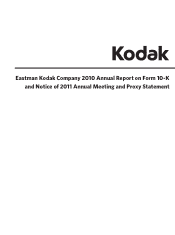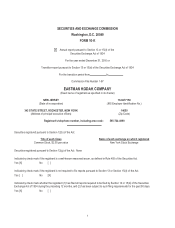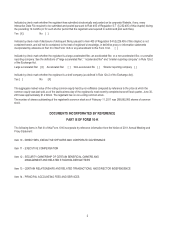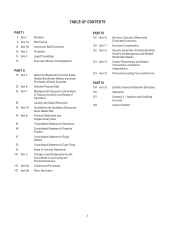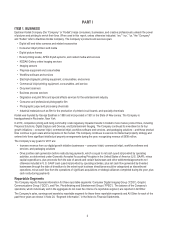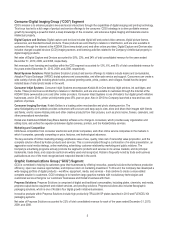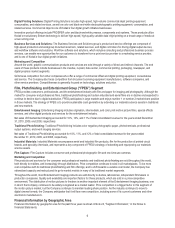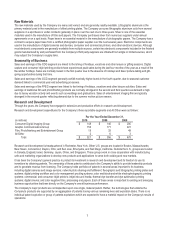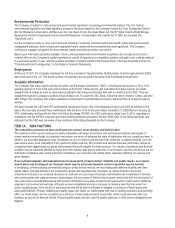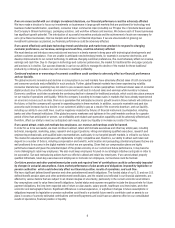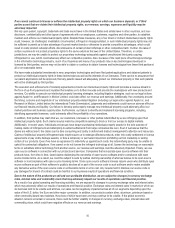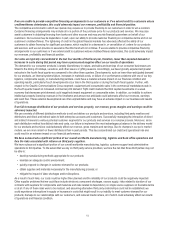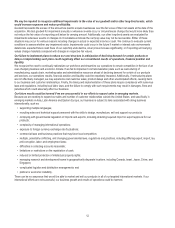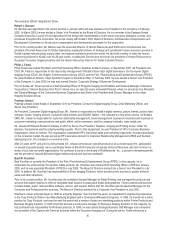Kodak 2010 Annual Report Download - page 9
Download and view the complete annual report
Please find page 9 of the 2010 Kodak annual report below. You can navigate through the pages in the report by either clicking on the pages listed below, or by using the keyword search tool below to find specific information within the annual report.
7
Raw Materials
The raw materials used by the Company are many and varied, and are generally readily available. Lithographic aluminum is the
primary material used in the manufacture of offset printing plates. The Company procures lithographic aluminum coils from several
suppliers on a spot basis or under contracts generally in place over the next one to three years. Silver is one of the essential
materials used in the manufacture of films and papers. The Company purchases silver from numerous suppliers under annual
agreements or on a spot basis. Paper base is an essential material in the manufacture of photographic papers. The Company has a
contract to acquire paper base from a certified photographic paper supplier over the next several years. Electronic components are
used in the manufacture of digital cameras and devices, consumer and commercial printers, and other electronic devices. Although
most electronic components are generally available from multiple sources, certain key electronic components included in the finished
goods manufactured by and purchased from the Company’s third party suppliers are obtained from single or limited sources, which
may subject the Company to supply risks.
Seasonality of Business
Sales and earnings of the CDG segment are linked to the timing of holidays, vacations and other leisure or gifting seasons. Digital
capture and consumer inkjet printing products have experienced peak sales during the last four months of the year as a result of the
December holidays. Sales are normally lowest in the first quarter due to the absence of holidays and fewer picture-taking and gift-
giving opportunities during that time.
Sales and earnings of the GCG segment generally exhibit modestly higher levels in the fourth quarter, due to seasonal customer
demand linked to commercial year-end advertising processes.
Sales and earnings of the FPEG segment are linked to the timing of holidays, vacations and other leisure activities. Sales and
earnings of traditional film and photofinishing products are normally strongest in the second and third quarters as demand is high
due to heavy vacation activity and events such as weddings and graduations. Sales of entertainment imaging film are typically
strongest in the second quarter reflecting demand due to the summer motion picture season.
Research and Development
Through the years, the Company has engaged in extensive and productive efforts in research and development.
Research and development expenditures for the Company’s three reportable segments and All Other were as follows:
For the Year Ended December 31,
(in millions)
2010
2009
2008
Consumer Digital Imaging Group
$ 148
$ 146
$ 205
Graphic Communications Group
152
171
221
Film, Photofinishing and Entertainment Group
19
33
49
All Other
2
6
3
Total
$ 321
$ 356
$ 478
Research and development is headquartered in Rochester, New York. Other U.S. groups are located in Boston, Massachusetts;
New Haven, Connecticut; Dayton, Ohio; and San Jose, Emeryville, and San Diego, California. Outside the U.S., groups are located
in Canada, England, Israel, Germany, Japan, China, and Singapore. These groups work in close cooperation with manufacturing
units and marketing organizations to develop new products and applications to serve both existing and new markets.
It has been the Company's general practice to protect its investment in research and development and its freedom to use its
inventions by obtaining patents. The ownership of these patents contributes to the Company's ability to provide leadership products
and to generate revenue from licensing. The Company holds portfolios of patents in several areas important to its business,
including digital cameras and image sensors; network photo sharing and fulfillment; flexographic and lithographic printing plates and
systems; digital printing workflow and color management proofing systems; color and black-and-white electrophotographic printing
systems; commercial, and consumer inkjet printers; inkjet inks and media; thermal dye transfer and dye sublimation printing
systems; digital cinema; and color negative films, processing and papers. Each of these areas is important to existing and emerging
business opportunities that bear directly on the Company's overall business performance.
The Company's major products are not dependent upon one single, material patent. Rather, the technologies that underlie the
Company's products are supported by an aggregation of patents having various remaining lives and expiration dates. There is no
individual patent expiration or group of patents expirations which are expected to have a material impact on the Company's results of
operations.

